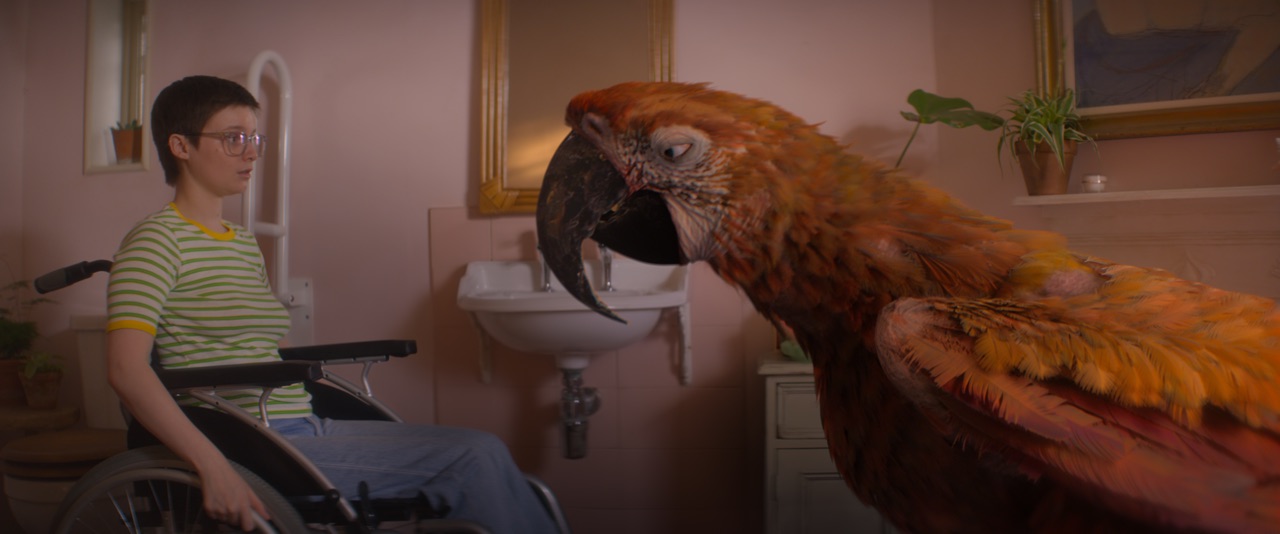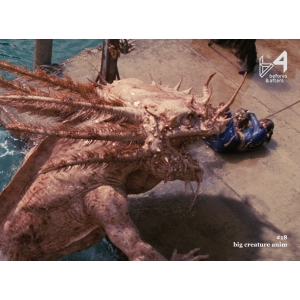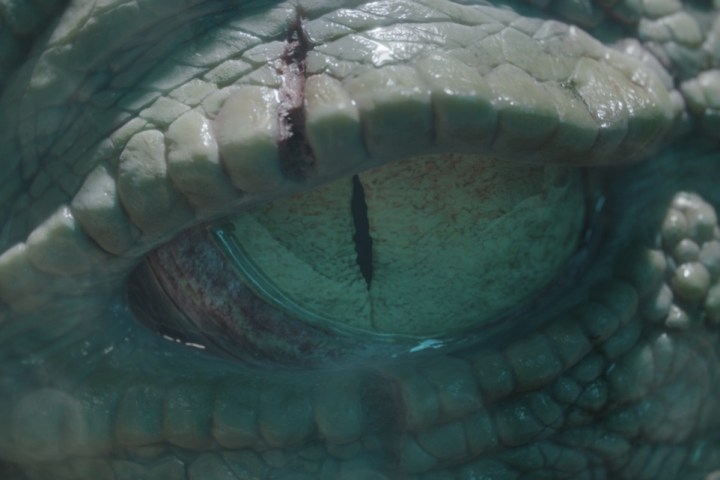Behind the on-set performance and visual effects in Daina O. Pusić’s film, starring Julia Louis-Dreyfus.
Daina O. Pusić’s Tuesday, from A24, is a film that follows the relationship between Tuesday (Lola Petticrew) and her mother Zora (Julia Louis-Dreyfus) and their experience with Death–a talking macaw.
Death is played by Arinzé Kene, and although he was ultimately realized as a CG bird, Kene was actually on set and in front of the camera for the performance of the character. When Death is shown human-sized and child sized Kene carried out the performance directly with the other actors.
When Death is shown much smaller, Kene was mostly off-screen, while a live feed of him was displayed on a monitor–which was even sometimes puppeteered–with the actors in the scene.
Here, Pusić and Kene tell befores & afters all about that unique style of the powerful performance, the on-set experience, and the liaison with the visual effects team, from ReDefine, to bring Death to life.
b&a: Daina, I’m always interested in going back to the beginning in terms of your first thoughts about how Death would be accomplished. What were your first conversations with anyone, maybe they were with a visual effects supervisor, maybe it was someone else who gave you some advice about how you would do this?
Daina O. Pusić: My very first conversation was with a friend called Simon Cartwright, who’s a stop-motion animator. We talked about puppets and the weight they bring, the quality of a puppet in a film. We talked a lot about shelf life as well, how having something real in front of the camera was likely to extend the shelf life of an effects driven creature.
So I started off talking to puppeteers because it was clear that the character having weight and presence was paramount. But, as I investigated puppeteering more and more, I realized that the range of emotions that the character had to express would be too vast and his size changes would also present a practical and financial problem.
There was the third concern, which was that I felt that a puppet would almost imply, or it would be more probable, that people could interpret that Death was imaginary, that he was a figment of a child’s imagination. It was important for him to be real.
All that started to spell out a human performance. It would have to be an actor in front of the camera, playing the scene just like any other actor. That was the beginning.
b&a: How did you come on board, Arinzé? When did you first hear about the project, and how did you get involved?
Arinzé Kene: I remember getting a script and just it being completely different to anything I had ever read. I was reading quite a lot of scripts at that time, a lot of film and television, because most of that was coming back [after the pandemic], but theater hadn’t really come back yet. I love theater, when it comes to performance, I love to play at the extremities. It was the only script that really caught my eye and really made me think and made me a little bit scared as well because I was like, ‘I don’t know how to do this one.’ I remember talking to my agent. I was like, ‘I’m not sure if I should tape for this because I don’t know what to do, and I don’t want to look like an idiot.’ I decided to tape. That’s where it began.
b&a: What were you hoping that someone like Arinzé would bring to this character, Daina?
Daina O. Pusić: A real and believable character. I had his psychological profile, his character background…and a lot of different people auditioned, and they had a lot of very, very different interpretations of what the character was but it’s a difficult one to get right. He is a parrot, yes. But he’s also a monster. He is pushed into being something otherworldly, because my feeling was that the audience would be more likely to believe a CGI monster than a CGI Macaw. In the same way a CGI dragon is more believable than a CGI dog; we have no frame of reference.
But I didn’t know how he would move exactly nor what the voice would sound like. I just knew who he was and what he needed to do. When Arinzé sent the tape, I just said, ‘Aha. Oh, that’s what he needs to do.’ It was that wonderful moment where someone comes on board and knows more than you. That’s always what you want as a director, is for someone to come and explain the script to you and explain the character to you. That’s what Arinzé’s tape did. He did the voice. He did the movements, and it was clear what the character was.

b&a: Arinzé, tell me about what actually happened on set and how the performance would go down for each take.
Arinzé Kene: I had no idea how we were going to do it. I didn’t realize I would be so much on set in the sight line of my cast. Daina said, ‘Yeah, you’re in. You’re amongst it. It’s happening with you in there.’ I’ve not done anything like it before. I loved being on set. I think I wouldn’t know what this film would be if it was just me in some studio. We were able to play off of each other in the scenes. They could hear my actual performance and see my actual performance because I was embodying a macaw the whole time. But also, I was embodying Death. I was trying to not just let it live in the voice but to live in the face, live in the expressions, live in the way that he moves and carries himself and the way that they move and carry themselves. It was really fun.
b&a: Daina, just in terms of practical considerations, when Death is large, did that mean that Arinzé was in the scene performing with the actors or actor, and then you would do, say, a clean plate without Arinzé? Tell me about how that actually worked from a practical point of view.
Daina O. Pusić: It was very scene-specific because he changes size. We needed to think of various solutions for various scenes. When he is human-sized or child-sized, Arinzé was in front of the camera, then a clean plate, then consecutive shots of a feather ball, which we constructed with feathers as a reference, and a silver ball. Those shots took time. In post-production, animators would animate directly over him. Any movement, any micro-movement you see the character do – that was all Arinze and the animators were simply translating his performance into the character.
Things got interesting when he got smaller. When he got to 20, 25 cm, for instance, Arinzé would be in the room, off-main camera, performing to his own separate camera which was connected to, and delivering a live feed, to a monitor that the other characters would perform opposite from in the scene. So, they would see and act opposite Arinze. Arinze would see their performance as well as he had a monitor of his own and they could hear each other’s voices as they where in the same room.
We recorded Arinze’s performances in those scenes, obviously, and Then, the animators would use those recordings as a direct reference when animating over the monitor. If he would move in any way, then we would puppeteer the monitor. There’s a scene where he jumps on the table. That was just the VFX crew puppeteering the monitor with these long metal beams. There is also a scene that required a wider and more complex range of movement, in it the character vapes, and in which Arinzé puppeteered a version of himself, a buck of himself. The animators then drew over his puppeteering and erased him from the scene.
There’s a scene where he’s very, very tiny inside Lola’s ear and Arinzé was in another room talking to them live in the scene through a mic in Lola’s ear. We basically did anything and everything we could to put Arinze in front of the camera. It just would not have worked any other way, not with the type of character we had/the type of budget we were on it/the interactions he has with the other characters. It just wouldn’t have worked.

b&a: I think it’s a great solution. I’m really curious, Arinzé, what you might’ve done to get yourself into that mindset of a macaw or parrot, whether you felt like you needed to do certain movements that a bird would do, or whether it was really much more about the emotions and the mood of the scene?
Arinzé Kene: I think I am quite a physical performer. Even when I did Death of the Salesman at the Young Vic, I found that part of my way into the character was through remembering that he’s a farm hand. He works with all kinds of animals. This is Biff. I always had to remember what his body feels like, someone who works out in the fields from five in the morning. So I found that with Death, it was a physical thing first, and then it was voice. Even in the tapes, I was reminding myself, ‘Don’t hold back. Do what feels right with the little information you have.’ My first tape, I hadn’t spoken to Daina yet. It was just with the script and with what you feel this character’s giving. What does it make you want to do?
The tape was closer to a bear, actually. It was closer to moving a bit more like a bear. Over the course of a workshop that we did, that’s where we found this parrot. We found the movement and the way that I could sustain this over the course of the shoot. It felt comfortable by the time we started. Even on those times when I was small and I was on the monitor, as Daina explained, I still would get into embodying the character.
Then, the voice was linked to the physical performance. You can’t just do it standing up with your arms down. I had to get into that mini squat to draw my arms back like these are some wings.
I got into performing when I was a young teen. When you’re young, you really play. You do a lot. There are no lines. You don’t draw the line between sing, dance, acting, whatever. You’re just doing it. It’s so fun. Tuesday was the most fun I’ve had on a film set ever. It’s because it was required. I think Daina must’ve been having fun when she put this whole thing together when she created this incredible story. But it reminded me of why I do this. I might never get to do something like this ever again. It’s very rare. I’m super grateful I had the opportunity.
b&a: After the on-set performance, Daina, what was your process in dealing with the visual effects team? It’s such an iterative process, you sometimes don’t get to see finals for a long time. What did you see early on, say, to continue to direct the performance?
Daina O. Pusić: We had a very close collaboration that was very detailed, very scene-specific weekly sessions that lasted three, four, sometimes five hours where each movement and layer of animation would be discussed in great detail. You really have to like visual effects to survive that.
The animation would be delivered to me in layers and each layer had to be approved and incorporated successfully into the edit in order to move onto the next layer. When Arinze was in front of the camera the performance animation would be more straightforward because it would directly replicate his performance but when he wasn’t the performance had to be built from his takes and that would be more complicated to put together.
Other than the performance we had to comb through his size changes, the pace and nature of them, the way his plumage would react to size changes, to light, how his appearance shifted throughout the film – from dirty and shabby to clean and regenerated…a lot of different things to consider and work into the edit as well as set up for later foley and sound design.
There’s also certain scenes in which the character doesn’t speak and Arinze wasn’t on set. Mainly the opening of the film. Those performances were built from scratch and we often used them in pre production to settle on his exact appearance, skeletal structure, how his feathers would react to his size changes. For instance, there’s a scene at the beginning where he runs towards this girl that’s dying, and he needs to be very menacing. But if he were to run as an oversized parrot, he would not look menacing at all. We had to construct his skeleton in a way that allowed for a strut that was more akin to a dinosaur, specifically to an Ornithomimus dinosaur.
There was a lot of work done in pre-production, which we then translated into post-production to follow and compliment Arinze’s performance. It was very detailed work.

b&a: Arinzé, what was it like for you when you first saw your performance translated to the CG parrot?
Arinzé Kene: I think I laughed because I could see my facial expressions in there.. I’m not one of those performers who is always running to video village after every take. I think the first bit I saw was that moment when he’s become very emotional as a result of being affected quite positively by this girl. All of a sudden, he can feel again. That was the first bit I saw. I burst out laughing because it was just so weird. I was like, ‘How is it possible?’ I didn’t realize Daina would go all the way to do it like that. Then, as I started seeing more bits, it was just truly fascinating. It’s another way of making it happen.
Actually, before doing the film, I checked out Andy Serkis and his journey through being that kind of performer. He really is the man. He’s really incredible. I just checked him out to see some behind-the-scenes stuff. I think he had a similar experience to me when he did Sméagol for the first time, in that he inspired the director to bring him on set.
So, it was really, really fascinating to see that coming through. I’m still fascinated by how they managed to still do it. I’m just so proud of what we did. It’s my favorite thing.
Daina O. Pusić: I agree. I just want to add that working with Arinzé and building his performance was one of the most gratifying moments of my filmmaking career so far, I have to say. We were operating on the very edge of what is possible and getting away with it day after day after day because Arinze’s wonderful performance combined with our technical approach and the way the character was designed created a chemistry that just worked. The mechanism worked. We got to just relax and have fun and go for it.
Then, building it in post-production as well was equally gratifying because I just had this incredible performance to work off of, and so did the entire VFX team. I should also say I’m not the only person who adored Arinzé and his performance. Everyone on set was totally blown away. The VFX team adored him. I remember the first time they realized that Arinzé’s performance was so accurate that they didn’t have to alter his shadows. They would huddle around me and whisper “His shadow is perfect, Daina. How is he creating the shadow of a giant parrot?!”













